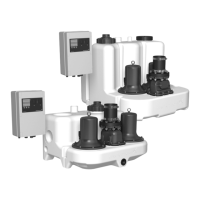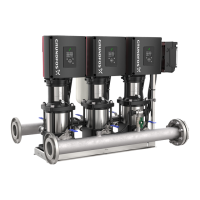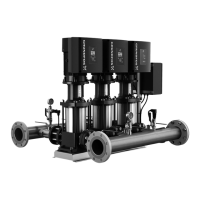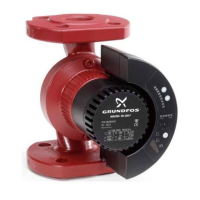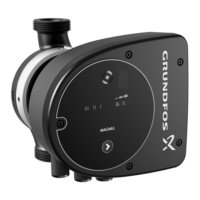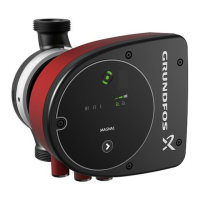English (GB)
27
Detailed description of pos. 5
7.2 Guidelines for installation of lifting station
The guidelines for correct mechanical installation of a lifting
station are according to EN 12056-4.
See section 7.1.1 Installation sketch.
• Install the lifting station in a properly lit and vented room with
60 cm free space around all parts to be serviced and operated.
• Provide a pump sump below the floor level. If a lifting station is
installed in a basement with the risk of penetrating
groundwater, it is advisable (in certain countries required) to
install a drainage pump in a separate pump sump below floor
level in order to drain the room. See fig. 18.
• All pipe connections must be flexible to reduce resonance.
• Lifting stations must be secured against uplift and twist.
• All discharge pipes from lifting station, diaphragm pump and
drainage pump must have a bend above the local backwater
level. The highest point of the bend/reversed water seal must
be above street level. See fig. 18.
• For discharge pipes, DN 80 and upwards, install an isolating
valve in the discharge pipe. Also provide an isolating valve in
the inlet line.
• Surface water must not be discharged into the lifting station
inside the building. It should have its own pumping station
outside the building.
• Lifting stations must be provided with an approved non-return
valve according to EN 12050-4.
• The volume of the discharge pipe above the non-return-valve
up to the backwater level must be smaller than the effective
tank volume.
• In general, a lifting station for black wastewater must be
vented above roof level. However, it is permitted to lead the
ventilation, as a secondary ventilation, into the main building
ventilation system. Special venting valves (accessory) should
be placed outside the building.
• If the wastewater is discharged into a collecting line, this
collecting line must have a filling ratio of at least h/d = 0.7.
The collecting line must be at least one nominal diameter
bigger after the discharge pipe connection.
• The controller must be placed in a flood safe place and be
equipped with an alarm.
Use a diaphragm pump for simple, manual draining of the
collecting tank in case of pump failure (not obligatory).
Figure Description
TM05 1497 2811
1 1/2" complete pre-assembled
discharge pipework for MOG:
– 1 x flexible connecting piece with
2 clamps DN 40
– 1 x hose nozzle Rp 1 1/2 / DN 40
– 1 x isolating valve (ball) R 1 1/2
– 2 x double nipple Rp 1 1/2
– 1 x non-return valve (ball) R 1 1/2
– 1 x bend 90 ° Rp 1 1/2 / R 1 1/2
Note: The oval flange with 1 1/4" inner
thread is supplied with MOG.
See section 2. Scope of delivery.
Figure Description
TM05 1498 2811
1 1/2" complete pre-assembled
discharge pipework for MDG:
– 1 x flexible connecting piece with
2 clamps DN 32
– 1 x hose nozzle Rp 1 1/2 / DN 40
– 1 x isolating valve (ball) R 1 1/2
– 1 x cross piece Rp 1 1/2
– 1 x blind cover Rp 1 1/2
– 2 x long nipple R 1 1/2
– 2 x bend 90 ° Rp 1 1/2 / R 1 1/2
– 2 x double nipple R 1 1/2
– 2 x non-return valve (ball) R 1 1/2
– 2 x bend 90 ° Rp 1 1/2 / R 1 1/4
Note: Two oval flanges with 1 1/4"
inner thread are supplied with MDG.
See section 2. Scope of delivery.
The collecting tank, pump and cables may be
flooded (max. 2 m for 7 days).
The controller must be installed in a dry and well
ventilated place.

